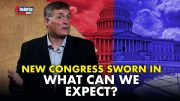
Now that the national elections are history, attention in Washington is firmly focused on the “fiscal cliff”: the day of reckoning created by the Congress during the budget ceiling debate in the summer of 2011. When the Super Committee failed in its mandate to create a plan to address the deficits and the national debt, the result was the misnamed Budget Control Act of 2011, which, in current parlance, kicked the budgetary impasse “can” to December 31, 2012. All that act did was to raise the debt limit immediately by $400 billion, thus averting a government shutdown, while allowing further increases in the debt limit without another congressional confrontation with the White House. The tradeoff was the promise of spending cuts in the future.
That future is now.
If nothing is done, and the economy runs off the so-called fiscal cliff, the impact will be a combination of $7 trillion worth of tax increases and spending cuts over the next decade. There will be automatic spending cuts of $120 billion annually in both defense and non-defense spending; there will be increases in income and capital gains tax rates and the reestablishment of the so-called “death tax” (the estate tax); 27 million households will now be subject to the “wealth tax” under the Alternative Minimum Tax (AMT), while those who are now enjoying the payroll tax “holiday” will see their Social Security withholding taxes return to the 6.2 percent rate from the current temporary 4.2 percent rate. There would also be the confluence of another flurry of spending cuts and tax increases, including a 27-percent cut to Medicare providers and at least four other tax increases embedded in ObamaCare.
According to the Heritage Foundation, the fiscal cliff will cost families making $70,000 a year more than $4,000 in additional taxes, while those with incomes of $24,000 a year will be socked with $1,100 in new taxes.
In simple terms, the fiscal cliff, according to investment manager Peter Schiff, “is simply a legal trigger that will trim the deficit in 2013 by automatically implementing spending cuts and tax increases. In other words, the government will spend less, and more of what it does spend will be paid for with taxes rather than debt.”
The result, according to Schiff, would be “that the federal budget deficit will be immediately cut in half, shrinking to approximately $641 billion in 2013 from the approximately $1.1 trillion in 2012.”
Unfortunately, all the discussions and debates taking place in Washington about how to deal with the so-called fiscal cliff crisis miss the point entirely because they are based on the misperception that the national debt is $16 trillion. In reality, the national debt, when all the promises that the government has made to everyone — China, Japan, the Social Security trust fund, Medicare, Medicaid, unemployment benefits, federal employee health and retirement benefits, healthcare and retirement benefits to veterans — are added up, exceeds $200 trillion, nearly 14 times larger than the amount to which Washington is willing to admit.
In that context, all the conversation and “serious debate” taking place in Washington is now seen for what it really is: tinkering and fiddling and posturing, while ignoring the elephant in the living room — the real national debt.
Professor of economics at Boston University Laurence Kotlikoff did the math and concluded that
the truth is far worse…. The truth is that our politicians have been very careful in their labeling of government receipts and payments so as to keep most of the coming bills … off the books….
I recently calculated the fiscal gap [which] measures the present value difference between all projected future federal expenditures (including interest) and all projected future values.
The fiscal gap is thus the true measure of our government’s total indebtedness….
How big is the fiscal gap?
Brace yourself: It’s $222 trillion.
Worse than that, it’s growing by $11 trillion every year. That’s 10 times larger than the perceived, assumed, “official” annual deficit over which Washington is currently wringing its hands.
Economist Gary North thinks the problem is so great that nothing short of default and bankruptcy will result. It’s not only Washington’s unwillingness to acknowledge that the problem is vastly larger than is perceived, it’s growing so fast that the current fight over the nibbling around the edges of the problem won’t have any impact at all:
We can be certain about this: there is no way to repay the obligations that the federal government has negotiated with the voters…. It has extended its promises vastly beyond its ability to deliver on [them].
And so, concludes North, default is the only option: “The government is going to have to renege on [its] promises.”
Even before Texas Representative Ron Paul decided to enter the race for the Republican Party’s nomination for president, he knew that those seeking the nomination were being disingenuous about the size of the national debt and about the need to address it seriously. In April 2011 he noted:
Even the most conservative budget that has been proposed by Republican leadership requires raising the debt ceiling by an additional $9 trillion by [the year] 2021.
This demonstrates absolutely that no one in power right now has any real intention of addressing our spending problems or paying down the debt. They simply expect to continue to borrow and run up more debt forever, without limit.
Within months of announcing his candidacy in May 2011, Paul’s campaign published his “Plan to Restore America,” calling his plan “bold but achievable,” which would rely on “the bully pulpit of the presidency, the power of the veto, and, more importantly, the united voice of freedom-loving Americans” to “implement fundamental reforms.”
The reforms included lowering the corporate tax rate (which, at 35 percent, is the highest in the world) to 15 percent, allowing corporations to “repatriate” capital without additional taxation, extending permanently all “Bush tax cuts,” ending the death tax, and eliminating all taxes on personal savings.
They also included repealing ObamaCare, the massively intrusive financial regulatory Dodd-Frank law, and the Sarbanes-Oxley Act, which puts U.S. corporations at a competitive disadvantage with foreign firms.
But he focused his primary attention on cutting spending massively. He promised, if elected, to cut $1 trillion in spending during his first year in office, partly by eliminating five unconstitutional federal agencies: the Departments of Energy, Commerce, Interior, Education, and Housing and Urban Development (HUD). He also promised to abolish the invasive Transportation Security Administration (TSA) and return responsibility for security back to airline owners. He would abolish corporate subsidies, end foreign aid, terminate foreign wars, and return most government spending back to 2006 levels.
Doing the math, Paul’s plan would eliminate government spending on the Department of Energy, which would save $42 billion a year and free up its more than 100,000 employees to work in the private sector, hence producing wealth instead of stunting capital creation. Eliminating HUD would save $48 billion annually and put its more than 10,000 employees back into the private sector. Terminating the Department of Commerce would save $11 billion a year and require its nearly 45,000 employees to find other work. Closing down the Department of the Interior would save $12 billion a year and take its more than 70,000 employees off the government payroll. And firing the Department of Education would save nearly $80 billion a year and move its more than 5,000 employees to the private market.
Eliminating the TSA and its harassment of private citizens would save $8 billion a year and force nearly 60,000 employees to find other work. Ending corporate subsidies would save nearly $100 billion a year, according to the Cato Institute, while pulling the plug on foreign aid would save another $50 billion or more every year. He promised to end foreign wars, which in Afghanistan and Iraq have already cost more than 6,500 American lives and $4 trillion in American treasure.
By cutting spending so significantly, it wouldn’t take long for the economy to recover from its current blood-letting, thus allowing those leaving their government jobs to find work in the private sector relatively rapidly.
Paul’s goal to bring most federal spending back to 2006 levels, when spending was only $2.6 trillion and the government came within $250 billion of balancing its budget, would put the government within shouting distance of a balanced budget, for the first time since 1957.
Following in Paul’s footsteps, here is what a president and a Congress would do if they were informed not only of the real size and danger of the national debt but also of the limits placed on government spending by the Constitution. At his inauguration, the president could invoke much of what President John F. Kennedy said in his speech to the Economic Club of New York on December 14, 1962:
America’s rise to world leadership in the century since the Civil War has reflected more than anything else our unprecedented economic growth….
It demonstrated for all to see the power of freedom and the efficiency of free institutions….
A prosperous and growing America is important not only to Americans, it is … of vital importance to the entire Western World.
We can and must do better, much better than we’ve been doing for the last five-and-a-half years….
[Our] economy is capable of producing, without strain, [much] more than we are producing today. Business earnings could be [vastly] higher than they are today….
The most direct and significant kind of federal action aiding economic growth is to make possible an increase in private consumption and investment demand — to cut the fetters which hold back private spending….
If government is to retain the confidence of the people, it must not spend more than can be justified….
The … best means of strengthening demand among consumers and business is to reduce the burden on private income and the deterrents to private initiative which are imposed by our present tax system….
[This administration has] pledged itself … to an across-the-board, top-to-bottom cut in personal and corporate income taxes….
Our present tax system … exerts too heavy a drag on growth…. It siphons out of the private economy too large a share of personal and business purchasing power…. It reduces the financial incentives for personal effort, investment and risk-taking. In short … the government’s most useful role is … to expand the incentives and opportunities for private expenditures….
[Accordingly, the government] should reduce net taxes….
Corporate tax rates must also be cut to increase incentives….
[Finally] the new tax bill should improve both the equity and the simplicity of our present tax system….
The present patchwork of special provisions and preferences lightens the tax loads of some only at the cost of placing a heavier burden on others. It distorts economic judgments and channels undue amounts of energy into efforts to avoid tax liability. All of this inhibits our growth and efficiency….
I am confident that the enactment of [such a bill] will in due course increase our gross national product by several times the amount of taxes actually cut. Profit margins will be improved, and both the incentive to invest and the supply of funds … for investment will be increased. There will be new interest in taking risks, in increasing productivity, in creating new jobs and new products for long-term economic growth….
An economy hampered by restrictive tax rates will never produce enough revenues to balance our budget — just as it will never produce enough jobs or enough profits.
Such a president, backed up by a Congress that recognizes reality and the disastrous costs of doing nothing and that is informed by the lessons of history and an understanding of the limits placed on government by the Founders of the Republic in the Constitution, could do all this, and much more besides.
The executive and legislative branches, recognizing the important but separate roles each has under that Constitution, could end the funding for other destructive and unconstitutional agencies such as the Drug Enforcement Administration (DEA), which currently spends more than $2 billion annually and employs more than 10,000 people to enforce the Controlled Substances Act. That act illegally overrides the constitutional limits placed on the federal government under the 10th Amendment, which leaves the prerogative for such decisions exclusively to the states.
They could end the Environmental Protection Agency (EPA) by simply refusing to fund it (to the tune of $8.6 billion a year) and letting its more than 17,000 employees go. They could terminate funding for the Bureau of Alcohol, Tobacco, Firearms and Explosives (BATFE) by cutting the budget of the Department of Justice (DOJ) by the $1 billion-plus annually it spends on that bureau, and requiring its 4,500 employees to find other work in the private sector. It would demand that the DOJ close down the bureau along with the reduction in its budget. This would have the ameliorative effect of eliminating the future potential for such travesties of justice as Ruby Ridge and the Waco siege in the 1990s; its “pilot program” that detained shoppers at gun shows in Virginia, interrogated them, and then confiscated their purchases between May 2004 and August 2005; and, most recently, its highly controversial “Fast and Furious” and “Project Gunrunner” operations.
It wouldn’t take long for the shrinkage in federal spending to drop below the government’s revenues, creating a surplus that would then be used to reduce federal tax rates imposed on citizens and begin to make massive reductions in the national debt.
By the time these terminations and eliminations are complete, some estimate that the cost of running the federal government to pay for its legitimate functions would be about one-third of its current budget, and this would put in play the defunding and termination of the Internal Revenue Service (IRS). For example, in 1900, government spending as a percentage of the country’s gross domestic product was less than seven percent. Today it is more than three times higher.
Ending the IRS would free up some 106,000 employees, save at least $11 billion a year, and end its proven abuses of its powers.
How might an informed electorate begin the process of putting in place such people? The National Center for Constitutional Studies (NCCS) offers a series of questions that voters could ask a candidate who is seeking their support. But prior to that, the voters themselves must become informed. NCCS and other organizations, such as The John Birch Society (JBS) and WallBuilders, offer educational materials to aid in that effort.
President Kennedy understood the obstacles facing him in his quest to reduce taxes and government power:
I do not underestimate the obstacles which the Congress will face in enacting such legislation. No one will be satisfied. Everyone will have his own approach, his own bill, his own reductions. A high order of restraint and determination will be required….
This nation can afford to reduce taxes … but we cannot afford to do nothing. For on the strength of our free economy rests the hope of all free nations. We shall not fail that hope — free men and free nations must prosper and they must prevail.
This article is an example of the exclusive content that’s only available by subscribing to our print magazine. Twice a month get in-depth features covering the political gamut: education, candidate profiles, immigration, healthcare, foreign policy, guns, etc. Digital as well as print options are available!



